Thomas Agnew & Sons
Thomas Agnew & Sons is a fine arts dealer in London that began life as part of in a print and publishing partnership with Vittore Zanetti in Manchester in 1817 which ended in 1835, when Agnew took full control of the company. The firm opened its London gallery in 1860, where it soon established itself as one of Mayfair's leading dealerships. Since then Agnew's has held a pre-eminent position in the world of Old Master paintings. It also had a major role in the massive growth of a market for contemporary British art in the late 19th century. In 2013, after nearly two centuries of family ownership, Agnew's was purchased privately and is now run by Lord Anthony Crichton-Stuart, a former head of Christie's Old Master paintings department, New York. [1] [2] [3]
History
Agnew's, as it is commonly called, has long held a prominent position in the Bond Street trade in Old Master pictures. The founder's sons, Sir William Agnew, 1st Baronet (1825–1910) and Thomas Agnew (1827–1883), were pivotal in the firm's rise in London, where Agnew's first established itself in 1860. Broadly speaking, Sir William's line produced the in-house connoisseurs (most notably C. Morland Agnew [1855–1931]), while Thomas's son, W. Lockett Agnew (1858–1918), inherited his father's commercial flair.
It was William Agnew who shifted the gallery trade to Old Masters. As The Times noted in Sir William's obituary, "in 1877 the firm had built rooms in 39 Old Bond Street (later called 43 Old Bond Street), and when the succession of Old Master exhibitions, the example of Sir Richard Wallace and the Rothschilds, and the revived passion for eighteenth-century architecture and furniture had turned the taste of the new rich men back to the older art, William Agnew was ready to find the pictures."
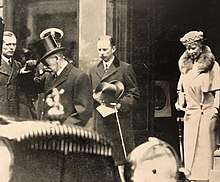
Agnew's acted as principal agent and advisor to Edward Cecil Guinness, 1st Earl of Iveagh (1847–1927). The firm also held a significant part in the collecting activities of Alfred Beit (1853–1906), John G. Johnson (1841–1917), Alfred de Rothschild (1842–1918), Ferdinand de Rothschild (1839–1898), Henry Clay Frick,[4] and George Salting (1835–1909). King George V (1865–1936) visited Agnew's Bond Street galleries on numerous occasions. Additionally, Agnew's often served as agent for the National Gallery in the salerooms. More recently, important clients include Paul Mellon (1907–1999), Norton Simon (1907–1993), and the Samuel Henry Kress Foundation. In the late 19th and early 20th century, the firm was well regarded not only by the era's leading collectors, but also by fellow dealers. Consequently, in Bond Street, Agnew's enjoyed friendly relations with Knoedler, Arthur Joseph Sulley (1853–1930), the Wertheimer brothers, and in Paris, Charles Sedelmeyer (1837–1925).
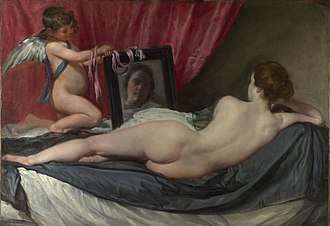
During the remainder of the 20th century and up to today, Agnew's has placed many masterpieces in major museums in Europe, America, and in emerging global markets. The contributions to the collections of the Metropolitan Museum of Art, the National Gallery of Art, Washington, DC, and the National Gallery, London, are noteworthy. The firm has handled major pictures by, amongst others, Caravaggio, John Constable, Van Dyck, El Greco, Guercino, Frans Hals, Poussin, Rembrandt, Rubens, Vermeer, Titian, Pontormo[5], J.M.W. Turner, Joseph Wright of Derby, and Velázquez, including the latter's Rokeby Venus in the National Gallery, London.
Agnew's also exhibited and sold works of Impressionist and Modern artists such as Paul Cézanne, Camille Pissarro, Paul Gauguin, Claude Monet, Pierre-Auguste Renoir, Edgar Degas, and Pablo Picasso. In recent years, the gallery has increasingly promoted the establishment of lesser-known artists of the early twentieth century, namely the German-Swedish painter and portraitist Lotte Laserstein.[6]
In 2008, the purpose-built gallery in Old Bond Street (1877), designed by Salomons & Wornum, was sold by Agnew's to Etro, the Italian fashion house. In 2013, after nearly two centuries of family ownership, Agnew's was purchased privately and has relocated its gallery premises to 6 St James's Place, London, under the directorship of art historian Lord Anthony Crichton-Stuart.[7] The Agnew family will continue as consulting participants in the firm's operation. The archive was given to the National Gallery.[8]
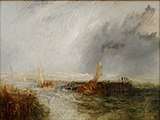 Joseph Mallord William Turner, R.A., Ostend, purchased from Agnew's in 1975 by the Neue Pinakothek, Munich.
Joseph Mallord William Turner, R.A., Ostend, purchased from Agnew's in 1975 by the Neue Pinakothek, Munich.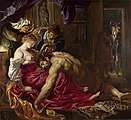 Sir Peter Paul Rubens, Samson and Delilah, purchased by Agnew's on behalf of the Trustees of the National Gallery in 1980, The National Gallery, London.
Sir Peter Paul Rubens, Samson and Delilah, purchased by Agnew's on behalf of the Trustees of the National Gallery in 1980, The National Gallery, London..jpg) Rembrandt van Ryn, Self Portrait in Old Age, purchased from Agnew's in 1888 by Sir E. C. Guinness, present owner: The Iveagh Bequest, Kenwood House.
Rembrandt van Ryn, Self Portrait in Old Age, purchased from Agnew's in 1888 by Sir E. C. Guinness, present owner: The Iveagh Bequest, Kenwood House.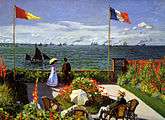 Claude Monet, Terrace at Sainte-Adresse, purchased from Agnew's by The Metropolitan Museum of Art, New York, 1967.
Claude Monet, Terrace at Sainte-Adresse, purchased from Agnew's by The Metropolitan Museum of Art, New York, 1967. Jan Vermeer, The Guitar Player, purchased from Agnew's in 1889 by Sir E. C. Guinness, present owner: The Iveagh Bequest, Kenwood House.
Jan Vermeer, The Guitar Player, purchased from Agnew's in 1889 by Sir E. C. Guinness, present owner: The Iveagh Bequest, Kenwood House.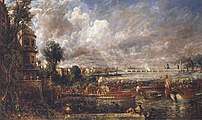 John Constable, The Opening of Waterloo Bridge, purchased from Agnew's in 1987 by The Tate Gallery, Tate Britain.
John Constable, The Opening of Waterloo Bridge, purchased from Agnew's in 1987 by The Tate Gallery, Tate Britain. Albrecht Dürer, Self-portrait, purchased from Agnew's in 1900 by Leopold Goldschmidt, present owner: The Louvre, Paris.
Albrecht Dürer, Self-portrait, purchased from Agnew's in 1900 by Leopold Goldschmidt, present owner: The Louvre, Paris._-_Google_Art_Project.jpg) Paul Gauguin, Mata Mua - in olden times, purchased by Agnew's in 1984 on behalf of Baron Thyssen and Jaime Ortiz-Patiño, present owner: Thyssen-Bornemisza Museum.
Paul Gauguin, Mata Mua - in olden times, purchased by Agnew's in 1984 on behalf of Baron Thyssen and Jaime Ortiz-Patiño, present owner: Thyssen-Bornemisza Museum._(Italian%2C_Florentine)_-_Portrait_of_a_Halberdier_(Francesco_Guardi%3F)_-_Google_Art_Project.jpg) Jacopo Carucci, called Pontormo, Portrait of a Halberdier, purchased by Agnew's on behalf of the J. Paul Getty Museum in 1989.
Jacopo Carucci, called Pontormo, Portrait of a Halberdier, purchased by Agnew's on behalf of the J. Paul Getty Museum in 1989. Josef Wright of Derby, Portrait of Colonel Charles Heathcote, oil on canvas, 127 x 100 cm, purchased from Agnew's in 2017 by The Cleveland Museum of Art.
Josef Wright of Derby, Portrait of Colonel Charles Heathcote, oil on canvas, 127 x 100 cm, purchased from Agnew's in 2017 by The Cleveland Museum of Art.
References
- Royal Academy of Arts Collections: Persons (Accessed August 2013)
- Chun, Dongho (2011) "Art Dealing in Nineteenth-Century England: The Case of Thomas Agnew", Horizons: The Seoul Journal of the Humanities, Vol. 2, No. 2 pp. 255-277
- Antiques Trade Gazette, 10 March 2014, New owners for Agnew’s as National Gallery buy archive (Accessed October 2018)
- Agnew, Lockett (September 2, 1899). "Letter from Agnew to Frick clarifying the shipment status of a picture by Reynolds ["Miss Puyeau"], in addition to Hoppner's "Miss Byng."". Letter to Henry Clay Frick. Archived from the original on 2017-04-27.
- Reif, Rita. "Old Master Auctioned For Record $35 Million". Retrieved 2018-11-08.
- "The shows not to miss during London Art Week Winter | Apollo Magazine". Apollo Magazine. 2017-11-28. Retrieved 2018-11-09.
- Antiques Trade Gazette, 10 March 2014, New owners for Agnew’s as National Gallery buy archive (Accessed October 2018)
- The National Gallery expands Research Centre through the acquisition of Agnew's archive on museum website
"Agnew's Gallery website". Thomas Agnew Ltd. Retrieved 3 March 2014.
External links
- official website: www.agnewsgallery.com
- Bendor Grosvenor, "Agnews to close", Art History News blog, February 2, 2013.
- Artkurio blog with press coverage of closure
- Thomas Agnew & Sons in Archives Directory for the History of Collecting in America at The Frick Collection